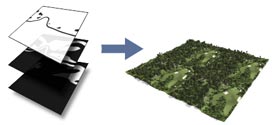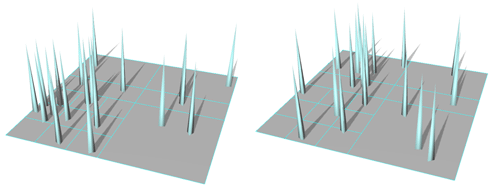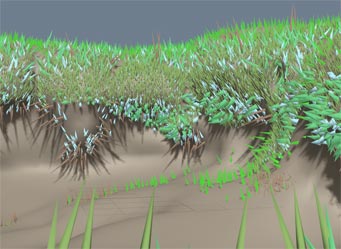Zones
Zones grow other geometry off of their surfaces.
Overview
![]()
A “Zone” is a type of generator with a single purpose: to generate other objects off of its surface. The 'Tree Generator' (at the root of the tree hierarchy) is a special type of zone that is omnipresent. Just like the 'Tree Generator', other zones define a area where branches, leaves, or proxies will grow off of.
 The picture on the left shows a disc zone in the 'Tree Window'.
By default, zones will appear as circular discs (they can also appear as meshes, but more on that later). The area inside of the disc will become populated by any generators linked to the zone. For these generators, a node with a position of “0.0” will appear in the center of the disc, while a node with a position of “1.0” will appear along the outer ring. Rotation is distributed radially in circular rings from the center outward.
A single zone generator can produce several zone nodes that are distributed in the same manner as leaves; e.g. each zone can have a unique distance and orientation with regards to its parent.
The picture on the left shows a disc zone in the 'Tree Window'.
By default, zones will appear as circular discs (they can also appear as meshes, but more on that later). The area inside of the disc will become populated by any generators linked to the zone. For these generators, a node with a position of “0.0” will appear in the center of the disc, while a node with a position of “1.0” will appear along the outer ring. Rotation is distributed radially in circular rings from the center outward.
A single zone generator can produce several zone nodes that are distributed in the same manner as leaves; e.g. each zone can have a unique distance and orientation with regards to its parent.
Clusters
A typical use for a disc zone would be in the creation of a “cluster” of grouped objects, such as ferns. Simply generating fern from the 'Tree Generator' isn't sufficient (each frond is solitary), nor is using a spine node (see below). If you look closely, you'll notice that there is no separation between the fronds using the spine generator, while the zone method allows for a widened growth radius for the fronds. This is more natural since rarely do objects grow out of a single discrete point in nature.

| (left) Fronds directly off of the tree node, (center) fronds coming from a spine generator, (right) fronds coming from a 'zone generator' |
|---|
Mesh Zones
![]()
Instead of using the default disc shape, a mesh asset can be used instead. Functionally, this will allow you to grow arbitrary generators directly off of the surface of the mesh.
Placing objects off of mesh zones
Since meshes are completely arbitrary pieces of geometry, objects growing off of them are hard to place in a meaningful fashion. As such, faces are chosen at random instead of from a known start and end point. We've put in place a few procedures for controlling the placement of objects growing off of zones:

- Use a mask asset or series of masks on the child generators. Masks can limit growth based on grayscale “knockout” images (mapped to the mesh's texture coordinates), by slope and elevation, or based on a UV texture coordinate range.
| Use the Adapt to masks option to honor the frequency value after masks have been applied. Otherwise, the actual number of nodes created may be far less than the specified frequency. However, “adapt to masks” has the downside of requiring recomputed positions every time a a mask asset is changed. |
|---|
- Use forces to limit the faces of the mesh that are eligible for growth. For instance, applying a directional force to a zone will only allow growth from faces that closely match the direction that the force is pointing. Use the Influence of forces property to adjust the effect.

| (left) no forces affecting the zone, (middle) a localized magnet force, (right) a direction force. |
|---|
- Use Area influence to achieve even growth over faces of any size.

| (left) no area influence. Children are clustered around smaller zone faces. (right) area influence enabled. Children are more evenly distributed. |
|---|
- Surface adhesion can be used to interpolate the direction of growth between the “up” direction of the zone and the face normal where the node is growing off of.

| (left) surface adhesion of 0.0, (right) surface adhesion of 1.0 |
|---|
| Keep in mind that all of the aforementioned placement options affect only objects growing off of the zone, not the zones themselves. Additional placement and orientation options are located on the generators that actually create the geometry growing on the zones. |
|---|
Mesh Zone Examples
Various examples of using mesh zones as a modeling feature can be found throughout our model library. The basic principle is that, instead of littering the zone's surface with proxies for world building, the surface can instead be littered with tree geometry, such as leaves. This is useful for generating clinging vines, ivy, or topiary shapes. A few interesting examples have been chosen and displayed below. Visit www.speedtree.com/trees/ to view our entire catalog.

World Building With Zones
Mesh zones can be used for “world building” – generating tree locations on a terrain that matches your final scene. If there are a lot of trees to be placed, doing it procedurally can cut down development time tremendously. Follow the link below for a complete tutorial on world building with zones and proxies:


| A rendered view and world building setup of the same scene. |
|---|